NCLEX RN: Nursing Delegation, Triage and Prioritization. Contains 76 most common Questions and Scenarios with Rationale
Document Content and Description Below
Question 1 of 76
The nurse is assigned to care for four clients. In planning client rounds, which client should the
nurse assess first?
1. A postoperative client preparing for discharge with a new
...
medication
2. A client requiring daily dressing changes of a recent surgical incision
3. A client scheduled for a chest x-ray after insertion of a nasogastric tube
4. A client with asthma who requested a breathing treatment during the
previous shift
Question 2 of 76
The nurse employed in an emergency department is assigned to triage clients coming to the
emergency department for treatment on the evening shift. The nurse should assign priority to
which client?
1. A client complaining of muscle aches, a headache, and history of
seizures
2. A client who twisted her ankle when rollerblading and is requesting
medication for pain
3. A client with a minor laceration on the index finger sustained while
cutting an eggplant
4. A client with chest pain who states that he just ate pizza that was made
with a very spicy sauce
Question 3 of 76
A nursing graduate is attending an agency orientation regarding the nursing model of practice
implemented in the health care facility. The nurse is told that the nursing model is a team
nursing approach. The nurse determines that which scenario is characteristic of the team-based
model of nursing practice?
1. Each staff member is assigned a specific task for a group of clients.
2. A staff member is assigned to determine the client's needs at home and
begin discharge planning.
3. A single registered nurse (RN) is responsible for providing care to a group
of 6 clients with the aid of an unlicensed assistive personnel (UAP).
4. An RN leads 2 licensed practical nurses (LPNs) and 3 UAPs in providing
care to a group of 12 clients.
Question 4 of 76
The nurse has received the assignment for the day shift. After making initial rounds and
checking all of the assigned clients, which client should the nurse plan to care for first?
1. A client who is ambulatory demonstrating steady gait
2. A postoperative client who has just received an opioid pain medication
3. A client scheduled for physical therapy for the first crutch-walking
session
4. A client with a white blood cell count of 14,000 mm3 (14.0 × 109/L) and a
temperature of 101°F (38.4°C)
Question 5 of 76
The nurse is giving a bed bath to an assigned client when an unlicensed assistive personnel
(UAP) enters the client's room and tells the nurse that another assigned client is in pain and
needs pain medication. Which is the most appropriate nursing action?
1. Finish the bed bath and then administer the pain medication to the
other client.
2. Ask the UAP to find out when the last pain medication was given to the
client.
3. Ask the UAP to tell the client in pain that medication will be
administered as soon as the bed bath is complete.
4. Cover the client, raise the side rails, tell the client that you will return
shortly, and administer the pain medication to the other client.
Question 6 of 76
The registered nurse is planning the client assignments for the day. Which is the most
appropriate assignment for an unlicensed assistive personnel (UAP)?
1. A client requiring a colostomy irrigation
2. A client receiving continuous tube feedings
3. A client who requires urine specimen collections
4. A client with difficulty swallowing food and fluids
Question 7 of 76
The nurse manager is discussing the facility protocol in the event of a tornado with the staff.
Which instructions should the nurse manager include in the discussion? Select all that apply.
1. Open doors to client rooms.
2. Move beds away from windows.
3. Close window shades and curtains.
4. Place blankets over clients who are confined to bed.
5. Relocate ambulatory clients from the hallways back into their rooms.
Question 8 of 76
The nurse employed in a long-term care facility is planning assignments for the clients on a
nursing unit. The nurse needs to assign four clients and has a licensed practical (vocational)
nurse and 3 unlicensed assistive personnel (UAPs) on a nursing team. Which client would the
nurse most appropriately assign to the licensed practical (vocational) nurse?
1. A client who requires a bed bath
2. An older client requiring frequent ambulation
3. A client who requires hourly vital sign measurements
4. A client requiring abdominal wound irrigations and dressing changes
every 3 hours
Question 9 of 76
The charge nurse is planning the assignment for the day. Which factors should the nurse remain
mindful of when planning the assignment? Select all that apply.
1. The acuity level of the clients
2. Specific requests from the staff
3. The clustering of the rooms on the unit
4. The number of anticipated client discharges
5. Client needs and workers' needs and abilities
Question 10 of 76
The nurse is giving a report to an unlicensed assistive personnel (UAP) who will be caring for a
client who has hand restraints (safety devices). The nurse instructs the UAP to check the skin
integrity of the restrained hands how frequently?
1. Every 2 hours
2. Every 3 hours
3. Every 4 hours
4. Every 30 minutes
.
Question 11 of 76
The nurse is conducting a session about the principles of first aid and is discussing the
interventions for a snakebite to an extremity. The nurse should inform those attending the
session that the first priority intervention in the event of this occurrence is which action?
1. Immobilize the affected extremity.
2. Remove jewelry and constricting clothing from the victim.
3. Place the extremity in a position so that it is below the level of the heart.
4. Move the victim to a safe area away from the snake and encourage the
victim to rest.
Question 12 of 76
The nurse manager is planning the clinical assignments for the day. Which staff members cannot
be assigned to care for a client with herpes zoster? Select all that apply.
1. The nurse who never had roseola
2. The nurse who never had mumps
3. The nurse who never had chickenpox
4. The nurse who never had German measles
5. The nurse who never received the varicella-zoster vaccine
Question 13 of 76
When creating an assignment for a team consisting of a registered nurse (RN), 1 licensed
practical nurse (LPN), and 2 unlicensed assistive personnel (UAP), which is the best client for the
LPN?
1. A client requiring frequent temperature checks
2. A client requiring assistance with ambulation every 4 hours
3. A client on a mechanical ventilator requiring frequent assessment and
suctioning
4. A client with a spinal cord injury requiring urinary catheterization every
6 hours
Question 14 of 76
The nursing instructor asks a nursing student to identify the priorities of care for an assigned
client. Which statement indicates that the student correctly identifies the priority client needs?
1. Actual or life-threatening concerns
2. Completing care in a reasonable time frame
3. Time constraints related to the client's needs
4. Obtaining needed supplies to care for the client
Question 15 of 76
The clinic nurse is caring for a client complaining of a foreign agent splashed into the eye. What
intervention should the nurse employ before treatment?
1. Put on gloves.
2. Evaluate the client's visual acuity.
3. Place the client in a supine position.
4. Place a strip of pH paper in the lower sac of the client's affected eye.
Question 16 of 76
The registered nurse (RN) is planning assignments for the clients on a nursing unit. The RN
needs to assign 4 clients and has 1 RN, 1 licensed practical (vocational) nurse, and 2 unlicensed
assistive personnel (UAPs) on a nursing team. Which client would the nurse most
appropriately assign to the licensed practical nurse?
1. The client who requires a 24-hour urine collection
2. The client with an abdominal wound requiring frequent wound
irrigations
3. The older client requiring assistance with a bed bath and frequent
ambulation
4. The client on a mechanical ventilator requiring frequent assessment and
suctioning
Question 17 of 76
The nurse is caring for a client with acute glomerulonephritis. The nurse instructs the unlicensed
assistive personnel (UAP) to implement which action when caring for the client?
1. Ambulate the client frequently.
2. Encourage a diet that is high in protein.
3. Remove the water pitcher from the bedside.
4. Monitor the client's temperature every 2 hours.
Question 18 of 76
The registered nurse is planning the client assignments for the day. Which is the most
appropriate assignment for the unlicensed assistive personnel (UAP)?
1. A client scheduled to receive parenteral nutrition
2. A client who requires assistance with ambulation every 4 hours
3. A client scheduled for discharge who needs teaching about medications
4. A client with bladder cancer who is scheduled for a cardiac
catheterization
Question 19 of 76
The nurse is planning the client assignments for a group of clients and has a licensed practical
nurse (LPN) and an unlicensed assistive personnel (UAP) on the nursing team. Which client
would the nurse most appropriately assign to the LPN?
1. A client with stable heart failure who has early-stage Alzheimer's disease
2. A client who is scheduled for an electrocardiogram and a chest x-ray
examination
3. A client who was treated for dehydration, is weak, and needs assistance
with bathing
4. A client with emphysema who is receiving oxygen at 2 L/min by nasal
cannula and becomes dyspneic on exertion
Question 20 of 76
The registered nurse (RN) is planning client assignments and cannot take a client assignment
today. Two unlicensed assistive personnel (UAP) and a licensed practical nurse (LPN) also are
assigned to the unit. Which client should the RN most appropriately assign to the LPN?
1. A client requiring frequent ambulation
2. A client scheduled for a cardiac catheterization
3. A client requiring range-of-motion (ROM) exercises
4. A client with a 24-hour urine collection who is on strict bed rest
Question 21 of 76
The registered nurse (RN) has provided instructions to a licensed practical nurse (LPN) regarding
administering enemas to a client scheduled for a barium enema. The RN has instructed the LPN
to administer enemas until they are clear. The LPN tells the RN that 3 enemas were
administered and that the returns are still not clear. What most appropriate instruction should
be given to the LPN?
1. Administer 1 more enema.
2. Stop administering the enemas.
3. Continue to administer enemas until the solution is clear.
4. Wait for 1 hour and then continue administering the enemas.
Question 22 of 76
A client with diabetes mellitus is admitted to the hospital for eye surgery. Which task can be
delegated to the unlicensed assistive personnel (UAP)?
1. Orient the client to the hospital surroundings.
2. Instruct the client on how to apply the eye drops.
3. Listen to the client express his frustration or loss.
4. Review hand washing and hygiene practices with the client.
Question 23 of 76
A registered nurse (RN) who is working with a nursing student assigns the student to care for a
client with a diagnosis of Cushing's syndrome. The RN asks the student questions about this
disorder. Which statement made by the student indicates understanding of Cushing's
syndrome?
1. "Cushing's syndrome is caused by excessive amounts of cortisol."
2. "Cushing's syndrome is caused by decreased amounts of aldosterone."
3. "Cushing's syndrome is caused by excessive amounts of antidiuretic
hormone."
4. "Cushing's syndrome is caused by decreased amounts of parathyroid
hormone."
Question 24 of 76
The nurse is planning the client assignments for the shift. Which client should the nurse assign
to the unlicensed assistive personnel (UAP)?
1. A client requiring dressing changes
2. A client requiring frequent temperature measurements
3. A client on a bowel management program requiring rectal suppositories
and a daily enema
4. A client with diabetes mellitus requiring daily insulin and reinforcement
of dietary measures
Question 25 of 76
A registered nurse is delegating activities to the nursing staff. Which activities are most
appropriate for the unlicensed assistive personnel (UAP)? Select all that apply.
1. Collecting a urine specimen from a client
2. Obtaining frequent oral temperatures on a client
3. Accompanying a client being discharged to his transportation to home
4. Assisting a postcardiac catheterization client who needs to lie flat to eat
lunch
5. Monitoring the amounts of fluid remaining in intravenous (IV) solution
bags for a client receiving IV fluids
Question 26 of 76
The registered nurse (RN) directs the licensed practical nurse (LPN) to assist with the care of a
client who has a sacral ulcer. Which is the most appropriate activity for the RN to delegate to
the LPN?
1. Place the client in a side-lying position.
2. Initiate wound care protocol for standardized ulcer care.
3. Meet with the wound specialist to identify measures to improve healing.
4. Determine which treatments would best meet the healing needs of the
client.
Question 27 of 76
The registered nurse is creating the plan for client assignments for the day. Which is the most
appropriate assignment for the unlicensed assistive personnel (UAP)?
1. A client scheduled to receive a blood transfusion
2. A client with bladder cancer who will be receiving chemotherapy
3. A client newly diagnosed with diabetes mellitus scheduled for discharge
4. A client on bed rest who requires range-of-motion (ROM) exercises
every 4 hours
Question 28 of 76
The nurse is preparing the client assignment. Which should be assigned to a licensed practical
nurse (LPN)?
1. A client who requires teaching about an insulin pump
2. Completing an admission assessment on a newly admitted client
3. Administration of a new oral medication to a client with Alzheimer's
disease
4. An assessment of a client whose pulse oximetry reading is 85% and who
is having difficulty breathing
Question 29 of 76
The nurse is rearranging the client assignments after several discharges and admissions
occurred. Which tasks should be assigned to the unlicensed assistive personnel (UAP)? Select all
that apply
1. Cleaning a client's dentures
2. Ambulating a postoperative client
3. Taking 4:00 p.m. vital signs on clients
4. Giving medications left by the nurse for the client to take
5. Assisting a client with a urinary drainage catheter into a chair
6.
Correct Obtaining a catheterized urinalysis and taking it to the laboratory
Question 30 of 76
The registered nurse (RN) is planning her client assignments for the day. She has a licensed
practical nurse and an unlicensed assistive personnel (UAP) on her team. Which task should the
RN delegate to the UAP?
1. Empty a client's urinary catheter bag.
2. Instruct a client on his new diabetic diet.
3. Teach a client how to check her blood glucose.
4. Evaluate a newly admitted client's home medications.
Question 31 of 76
The nurse is delegating the morning hygienic care of a man to the unlicensed assistive personnel
(UAP). In reviewing the assigned tasks, the nurse should instruct the UAP to use an electric razor
for which client?
1. The client with severe pain related to osteoporosis
2. The client with hypokalemia related to diuretic therapy
3. The client with thrombocytopenia related to chemotherapy
4. The client with an elevated white blood cell count related to infection
Question 32 of 76
The nurse is planning the client assignments for the day. Which clients can be safely assigned to
the unlicensed assistive personnel (UAP)? Select all that apply.
1. The client receiving a heparin infusion
2. The client receiving a blood transfusion
3. The client receiving continuous oxygen at 2 L/min
4. The client recovering from Guillain-Barré syndrome
5. The client who just returned from surgery for a hip repair
6. The client on isolation for methicillin-resistant Staphylococcus aureus
Question 33 of 76
The nurse is planning the client assignments for the day. Which clients can be safely assigned to
the unlicensed assistive personnel (UAP)? Select all that apply.
1. A client needing a bed bath
2. A client needing to ambulate
3. A client needing packed red blood cells
4. A client requiring assistance with feeding
5. A client needing to have vital signs checked
6. A client needing to use the bedside commode
Question 34 of 76
The nurse is responsible for the care of a client who has begun to experience hallucinations
more frequently. Which activity in the care of the client can be most appropriately delegated to
an unlicensed assistive personnel (UAP)?
1. Determining if the client has consistently been medication compliant
2. Providing distraction for the client by engaging the client in a board
game
3. Discussing the frequency and duration of the hallucinations with the
client
4. Assisting the client in identifying any new stressors he or she may be
experiencing
Question 35 of 76
The nurse is planning the client assignments for the day. Which clients can be safely assigned to
the unlicensed assistive personnel (UAP)? Select all that apply.
1. A confused older client who requires feeding
2. A client who requires turning every 2 hours
3. A client admitted with dehydration who is on strict intake and output
4. A client on 3 L of oxygen by nasal cannula and a pulse oximetry reading
of 89%
5. A client who experienced a 10-beat run of ventricular tachycardia and
hypotension on the previous shift
6. A client 4 days postoperative after exploratory laparotomy who requires
ambulation in the hallway 4 times a day
The nurse is preparing to perform a general survey of a client who was admitted to the hospital
a few hours ago. Which components of the general survey may be delegated to the unlicensed
assistive personnel (UAP)? Select all that apply.
1. Inspecting skin surfaces
2. Observing the client's behavior
3. Measuring the client's height and weight
4. Assessing the client's general appearance
5. Monitoring oral intake and urinary output
Question 37 of 76
The nurse is planning client assignments for the day. Which clients can be safely assigned to
unlicensed assistive personnel (UAPs)? Select all that apply.
1. Client who is receiving chemotherapy and is in isolation
2. Client with anemia who is receiving a second unit of blood and needs
assessment of vital signs
3. Client newly diagnosed with hyperthyroidism who is in need of teaching
regarding medication therapy
4. Client who is 72 hours postoperative recovering from a total knee
replacement and needs assistance with bathing and dressing
5. Client who is 48 hours postoperative recovering from an open reduction
and fixation of the right forearm and needs assistance with feeding
6. Client who is newly admitted with shortness of breath, circumoral
cyanosis, and a respiratory rate of 30 breaths per minute who requires
an admission assessment
Question 38 of 76
The nurse should instruct the unlicensed assistive personnel (UAP) to avoid the use of a straight
razor for which client?
1. The postoperative client
2. The client taking warfarin
3. The client with an infection
4. The client taking acetaminophen
Question 39 of 76
The nurse is developing a client care assignment for a group of unlicensed assistive personnel
(UAPs). What is the nurse's first step in planning and assigning clients?
1. Determine what skills can be delegated.
2. Determine the years of experience of each UAP.
3. Determine how much supervision is required for each client assigned.
4. Determine how many clients the agency allows to be delegated to each
UAP.
Question 40 of 76
The newly appointed vice president for nursing operations has announced that the authority for
decision making will be decentralized and distributed throughout the organization. Which term
describing this organizational chart should the vice president employ while talking with the
employees?
1. Flat
2. Vertical
3. Circular
4. Horizontal
Question 41 of 76
The graduate nurse is interviewed by the manager of a unit and is told that the manager's
leadership style is laissez-faire or one of letting the staff nurses make the decisions about the
unit's operations. Which question by the graduate nurse indicates the best understanding of the
laissez-faire leadership style?
1. "As the manager, do you maintain control and make all decisions?"
2. "As the manager, do you assume a passive, nondirective approach?"
3. "As the manager, do you facilitate decision making within the group?"
4. "As the manager, do you change style according to the needs of the
group?"
.
Question 42 of 76
The nurse manager meets with the staff nurses and announces that management has
developed a new policy and procedure that is significantly different from old practices. Which
statement by the nurse manager reflects the manager's use of legitimate power?
1. "The health care system services a client population that presents
particular challenges. The changes made will enhance client safety and
reduce errors."
2. "If you don't follow the new policy and procedure, I'll have no choice but
to give you a notice about poor performance, which could lead to
termination of your employment."
3. "Every manager has the responsibility to see that these new policies and
procedures are followed 100% of the time. Please join me in this
organization's effort to continue to improve quality care."
4. "You're just going to have to trust me on this one. I was a member of the
committee that wrote the policy and procedure, and there are good
reasons why the specific nursing actions need to be done this new way."
Question 43 of 76
Which tasks should the registered nurse (RN) delegate to the licensed practical nurse
(LPN)? Select all that apply.
1. Assessment
2. Urinary catheterization
3. Endotracheal suctioning
4. Intramuscular medication administration
5. Subcutaneous medication administration
6. Intravenous push medication administration
Question 44 of 76
A child with an autism spectrum disorder (ASD) is being admitted to the hospital for diagnostic
tests. Which room assignment is the most appropriate for the child?
1. Private room
2. Semiprivate room
3. 4-bed ward room
4. Contact isolation room
Question 45 of 76
The labor and delivery room nurse has just received reports on 4 clients. After reviewing the
client data, the nurse should assess which client first?
1. A primigravida client in the active stage of labor
2. A multigravida client who was admitted for induction of labor
3. A client who is not contracting but has suspected premature rupture of
the membranes
4. A client who has just received an intravenous loading dose of
magnesium sulfate to stop preterm labor
Question 46 of 76
The nurse has developed a teaching plan for a client with hypertension regarding the
administration of prescribed medications. What is the initial nursing action?
1. Set priorities for the client.
2. Assess the client's readiness to learn.
3. Find out whether anyone lives with the client.
4. Use only 1 teaching method to prevent confusion.
Question 47 of 76
A client with cancer is receiving intravenous morphine sulfate for pain. When writing the plan of
care for this client, the nurse should include which action as the priority action?
1. Monitor temperature.
2. Monitor urine output.
3. Monitor respiratory status.
4. Encourage increased fluids.
Question 48 of 76
The nurse notes blanching, coolness, and edema at a client's peripheral intravenous (IV) site.
Which nursing action is the priority?
1. Remove the IV catheter.
2. Apply a warm compress.
3. Check for a blood return.
4. Measure the area of infiltration.
Question 49 of 76
The nurse is caring for 4 pediatric clients. After receiving reports from the night shift, which
child should the nurse assess first?
1. A 6-year-old child being treated for bacterial meningitis and on the tenth
day of antibiotic treatment
2. A 6-week-old infant admitted to the hospital for decreased level of
consciousness; shaken baby syndrome is suspected
3. A 2-year-old child with cerebral palsy being admitted to the hospital for
surgical placement of a gastrostomy feeding tube the next day
4. A 16-year-old child with a ventriculoperitoneal shunt that was placed at
birth for hydrocephalus; possible shunt malfunction is suspected, and
the child is scheduled and ready for a computed tomography (CT) scan
of the head
Question 50 of 76
The nurse is assigned to 4 clients on a postoperative surgical unit at a rural hospital. When
prioritizing the care, the nurse recognizes that the highest priority is focused on which client?
1. The client who lacks knowledge regarding postoperative home care
2. The client with problems clearing the airway related to abdominal
incision pain
3. The client with tissue perfusion alterations related to postoperative
venous stasis
4. The client who is at risk for infection related to a history of smoking for
20 years
Question 51 of 76
The emergency department nurse is caring for a child with suspected epiglottitis and has
ensured that the child has a patent airway. Which action is the next priority in the care of this
child?
1. Prepare the child for tracheotomy.
2. Prepare to administer epinephrine.
3. Prepare the child for a chest radiograph.
4. Assist the health care provider with intubation.
Question 52 of 76
The nursing instructor asks the nursing student to identify the priorities of care for an assigned
client. The nursing instructor determines that the nursing student understands the client's
needs when which statement is made?
1. "Actual or life-threatening concerns are the priority."
2. "Completing care in a reasonable time frame is the priority."
3. "Time constraints related to the client's needs are the priority."
4. "Obtaining the needed supplies to care for the client is the priority."
Question 53 of 76
A hospitalized client with type 1 diabetes mellitus received Humulin N and Humulin R insulin 2
hours ago (at 7:30 a.m.). The client calls the nurse and reports that he is feeling hungry, shaky,
and weak. The client ate breakfast at 8 a.m. and is due to eat lunch at noon. Arrange the
actions that the nurse will take in the order that they should be performed. All options must
be used.
1
2 3 4 5 6 Question 54 of 76
An emergency department nurse is preparing to receive 4 clients as a result of a motor vehicle
crash. Which victim should the nurse attend to first?
1. A child with a bleeding laceration
2. A 54-year-old woman with a fractured wrist
3. A 67-year-old woman with first-degree burns on her hands and arms
4. A 45-year-old man with chest pain, shortness of breath, and diaphoresis
Question 55 of 76
The nurse is assigned to care for 4 clients. Which client should the nurse assess first?
1. A client who has a tympanic temperature of 99.8°F
2. A client who has a regular radial pulse of 96 beats/minute
3. A client who has a supine resting blood pressure of 148/90 mm Hg
4. A client who has a peripheral (index finger) oxygen saturation
percentage of 85%
Correct
Question 56 of 76
The nurse has received her client assignment for the day. Which client should the nurse care
for first?
1. A client requiring a preoperative intravenous antibiotic
2. A client with emphysema who has shortness of breath after just
ambulating
3. A client with serous drainage on an incisional spinal wound post
laminectomy
4. A client with postoperative pain reported at 7 out of 10, with 10 being
the worst
Question 57 of 76
The nurse has received the client assignment for the day. Which client should the nurse care
for first?
1. The client receiving chemotherapy who is on day 3 of a 5-day regimen
and has a question about nutrition
2. The client receiving external radiation who has complaints of dryness
and itching skin at the treatment area
3. The client who had a radical mastectomy 36 hours ago and is
complaining of tightness and pulling at the incision site
4. The client admitted with the medical diagnosis of neutropenia who is
afebrile and is complaining of pain with urination
Question 58 of 76
The nurse is the first responder at the scene of a 6-car crash on a highway. Which victim should
the nurse attend to first?
1. A victim experiencing dyspnea
2. A victim experiencing confusion
3. A victim experiencing tachycardia
4. A victim experiencing intense pain
Question 59 of 76
The nurse in charge of a nursing unit is asked to select the hospitalized clients who can be
discharged so that hospital beds can be made available for victims of a community disaster.
Which clients can be safely discharged? Select all that apply.
1. A client with chest pain
2. A client with a Holter monitor
3. A client receiving oral antibiotics
4. A client experiencing sinus rhythm
5. A client newly diagnosed with atrial fibrillation
6. A client experiencing third-degree heart block who requires a
pacemaker
Question 60 of 76
The nurse has received her client assignment for the day. Which client should the nurse
check first?
1. A client experiencing severe pain
2. A client who is hearing voices in his head
3. A client who has just returned from surgery
4. A client who is in 4-point leather restraints
Question 61 of 76
The nurse is a responder at the scene of a building collapse. Which victim should the nurse care
for first?
1. Victim with an open fracture of the left lower extremity
2. Victim who is crying hysterically and complaining of pain in the right
ankle
3. Victim who is unresponsive and not breathing and whose left pupil is
fixed and dilated
4. Victim with an apparent chest wall defect and asymmetrical chest wall
movement
Question 62 of 76
The nurse manager of a medical-surgical unit is asked to select the hospitalized clients who can
be discharged so that hospital beds can be made available for victims of a community disaster.
Which clients can be safely discharged? Select all that apply.
1. Client postoperative day 1 after inguinal herniorrhaphy, vital signs stable
2. Client 5 days after a myocardial infarction, vital signs stable, absence of
dysrhythmias
3. Client 1 day after cardiac catheterization, normal study results, groin site
free of hematoma
4. Client who is vomiting, unable to take oral fluids, and receiving
intravenous fluids at 125 mL/hr
5. Client on nasal oxygen at 3 L/min, bibasilar crackles, and pulse oximetry
readings of 88% to 92%
6. Client with white blood cell count of 2200 mm3 (2.2 × 109/L),
temperature of 102°F (38.9°C), and blood pressure of 90/40 mm Hg
Question 63 of 76
The nurse is the first responder at the scene of an accident in which a tire blowout caused a bus
to roll over several times. Which victim should the nurse attend to first?
1. The 11-year-old with burns to 10% of both legs
2. The sobbing 10-year-old with an obvious fracture of the forearm
3. The unconscious 14-year-old whose breathing is shallow at 12
respirations per minute
4. The confused 12-year-old with bright red blood pulsing from an open
fracture of the femur
Question 64 of 76
The nurse in charge of a nursing unit is asked to select those hospitalized clients who can be
discharged so that hospital beds can be made available for victims of a community disaster.
Which clients can be safely discharged? Select all that apply.
1. The client with heart failure (HF) who has bilateral rhonchi
2. The client who 24 hours earlier gave birth to her second child by
caesarean delivery
3. The 48-hour postoperative client who has undergone an ileostomy
because of ulcerative colitis
4. The client with peritonitis caused by a ruptured appendix who is febrile
with a temperature of 102°F (38.9°C)
5. The 2-day postoperative client who has undergone total knee
replacement and is ambulating with a walker
6. The 3-day postoperative client who has undergone coronary artery
bypass grafting and is ready for rehabilitation
Question 65 of 76
The nurse has received her client assignment for the day. Which client should the nurse care
for first?
1. The 43-year-old client admitted for observation who has absence of
bowel sounds
2. The 53-year-old client with heart failure who has gained 4 pounds (1.8
kg) since yesterday and is short of breath
3. The 49-year-old client who is scheduled for surgery within the next 2
hours and will undergo a hysterectomy
4. The 12-hour postoperative client who has undergone pneumonectomy
and is completing a blood transfusion
Question 66 of 76
During morning report, the day nurse is given information on the assigned clients. Which client
should the nurse assess first?
1. The 80-year-old client with metastatic cancer to the brain who is
confused and on 1-to-1 observation with a sitter in the room
2. The 55-year-old client with breast cancer who is scheduled for a
computed tomographic (CT) scan of the brain at 0900 to rule out
metastasis
3. The 60-year-old client with leukemia who is receiving the first round of
chemotherapy, which was started at 0630 and is scheduled to end at
noon
4. The 70-year-old client who was admitted at 0500 with the medical
diagnosis of pneumonia and a temperature of 102.6°F (39.2°C). This
client received acetaminophen at 0600 and now has a temperature of
100.0°F (37.8°C).
Question 67 of 76
The nurse determines that which client has the highest priority needs?
1. The client who has a rectal temperature of 99.8°F
2. The client who has a blood pressure of 110/70 mm Hg
3. The client who has an oxygen saturation percentage of 95%
4. The client who has an irregular apical pulse of 120 beats per minute
Question 68 of 76
When planning care, which client should the nurse assess first?
1. The client with a chest tube for a pneumothorax
2. The client who had a cholecystectomy 2 days earlier
3. The client who is receiving total parenteral nutrition and lipids
4. The client who is on contact isolation for methicillin
resistant Staphylococcus aureus (MRSA)
Question 69 of 76
The nurse assigned to 4 clients reviews client data at the beginning of the shift. To which
information should the nurse give highest priority?
1. Urine output 240 mL/8 hr
2. Pulse oximetry reading 89%
3. Hemoglobin 12.2 g/dL (122 mmol/L)
4. Potassium level 3.6 mEq/L (3.6 mmol/L)
Question 70 of 76
A home health care nurse is planning client visits and nursing activities for the day. The nurse
begins the visits at 9 a.m. All clients live within a 5-mile radius. In order of priority, how the
nurse should plan the assignments for the day? Arrange the actions in the order that they
should be performed. All options must be used.
.
Question 71 of 76
A unit of packed red blood cells has been prescribed for a client with low hemoglobin and
hematocrit typing and crossmatching. The nurse receives a telephone call from the blood bank
and is informed that the unit of blood is ready for administration. In order of priority, how
should the nurse plan the actions to take? Arrange the actions in the order that they should be
performed. All options must be used.
Verify the health care provider's
(HCP's) prescription for the blood
transfusion.
Ensure that an informed consent has
been signed.
Insert an 18- or 19-gauge intravenous
catheter into the client.
Obtain the unit of blood from the
blood bank.
Ask a licensed nurse to assist in
confirming vital signs and blood
compatibility and verifying client
identity.
Hang the bag of blood.
1
Question 72 of 76
client is experiencing hypertonic uterine contractions. In order of priority, how should the nurse
plan the actions to take? Arrange the actions in the order that they should be performed. All
options must be used.:
1
Question 73 of 76
After correctly completing the rights of medication administration, performing hand hygiene,
and ensuring the correct position of the client, which steps should the nurse take to administer
medication via a volume control container? Arrange the actions in the order that they should
be performed. All options must be used.
Correct Answers: Your Answers:
Fill volume control container with
desired amount of IV fluid by opening
1 Fill volume control container with
desired amount of IV fluid by opening
clamp between volume control
container and main IV bag.
Close the clamp and check to be sure
that clamp on air vent volume control
container is open.
Clean injection port on top of volume
control container with an antiseptic
swab.
Remove the needle cap and insert the
needleless syringe tip through the
port, and then inject the medication
and label volume control container
with name of medication, dosage,
total volume including diluents, and
time of administration.
Regulate intravenous (IV) infusion rate
to allow medication to infuse in the
time recommended by institutional
policies.
Dispose of the syringe in puncture
proof and leak-proof container.
Discard supplies and perform hand
hygiene.
clamp between volume control
container and main IV bag.
Close the clamp and check to be sure
that clamp on air vent volume control
container is open.
Clean injection port on top of volume
control container with an antiseptic
swab.
Remove the needle cap and insert the
needleless syringe tip through the
port, and then inject the medication
and label volume control container
with name of medication, dosage,
total volume including diluents, and
time of administration.
Regulate intravenous (IV) infusion rate
to allow medication to infuse in the
time recommended by institutional
policies.
Dispose of the syringe in puncture
proof and leak-proof container.
Discard supplies and perform hand
hygiene.
Question 74 of 76
The nurse is the first responder at the scene of a train accident. Which victim should the nurse
attend to first?
1. A victim experiencing excruciating pain
2. A victim experiencing moderate anxiety
3. A victim experiencing airway obstruction
4. A victim experiencing altered level of consciousness
Question 75 of 76
The nurse in charge of a nursing unit is asked to select the hospitalized clients who can be
discharged so that hospital beds can be made available for victims of a community disaster.
Select the clients who can be safely discharged. Select all that apply.
1. A client with dyspnea
2. A client experiencing sinus rhythm
3. A client receiving oral anticoagulants
4. A client with chronic atrial fibrillation
5. A client experiencing third-degree heart block
6. A client who has not voided since before surgery
Question 76 of 76
Which client should the emergency department triage nurse classify as emergent?
1. A client with a displaced fracture who is crying
2. A client with a simple laceration and soft tissue injury
3. A client with crushing substernal pain who is short of breath
4. A client with a temperature of 101°F (38.3°C) with a productive cough
[Show More]
Last updated: 3 years ago
Preview 1 out of 46 pages
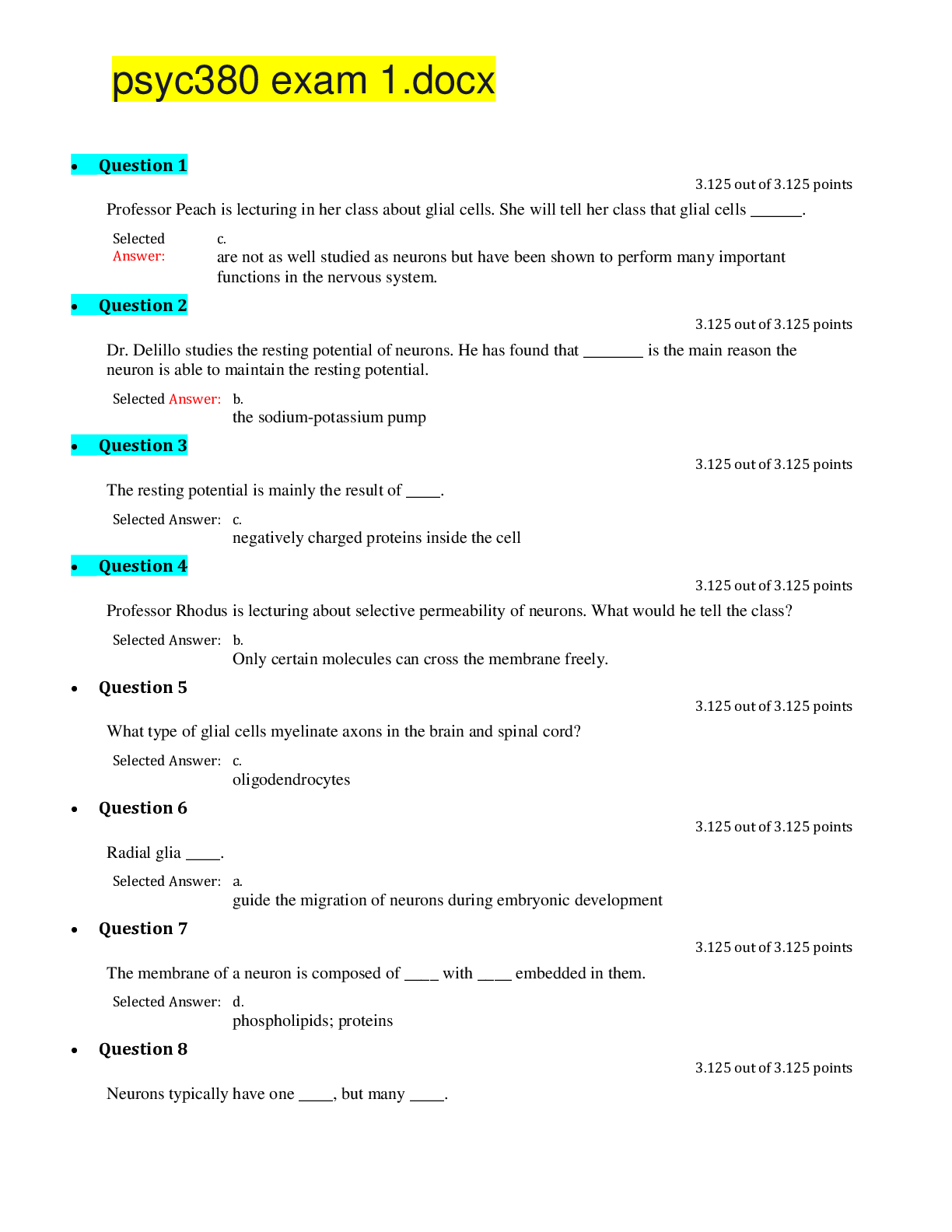
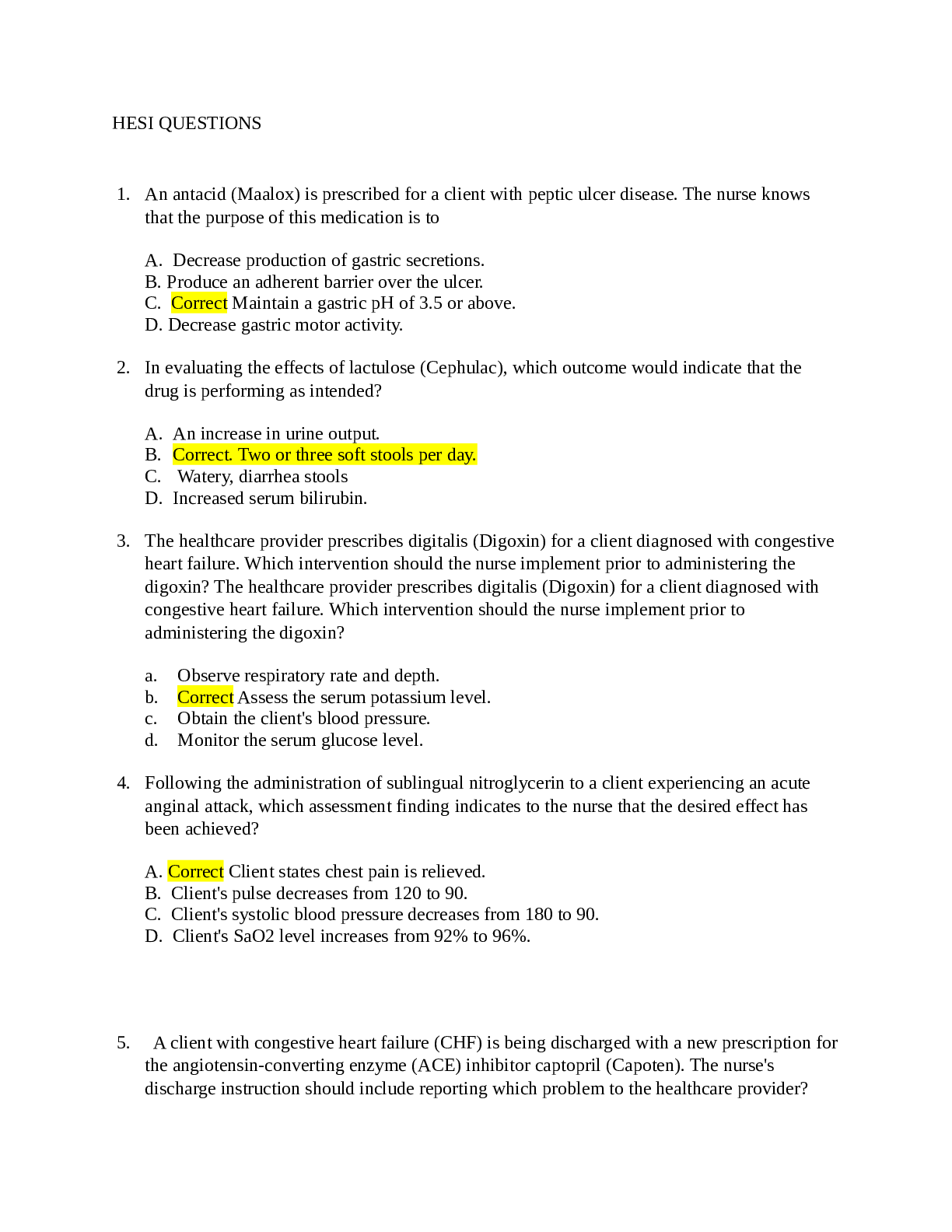



.png)


.png)


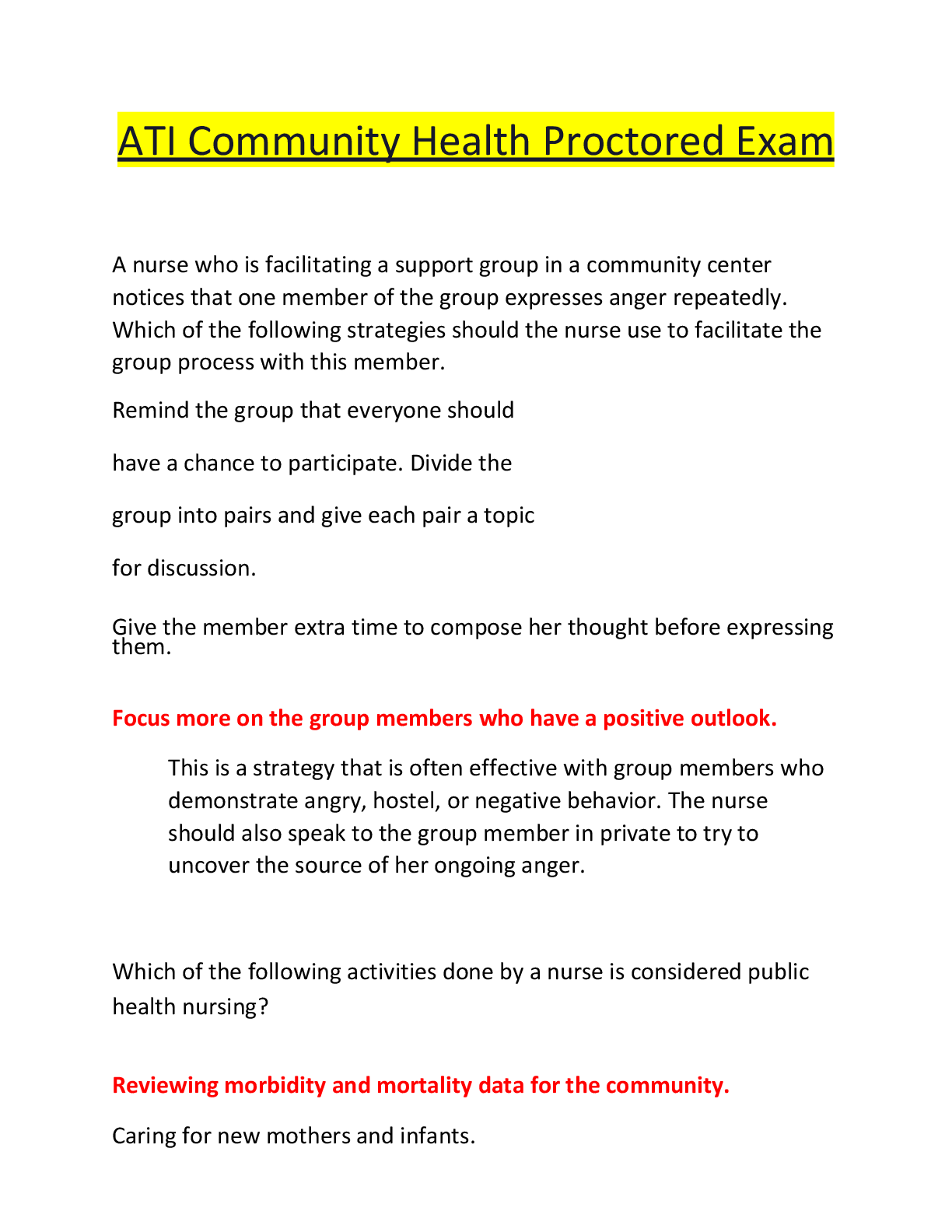












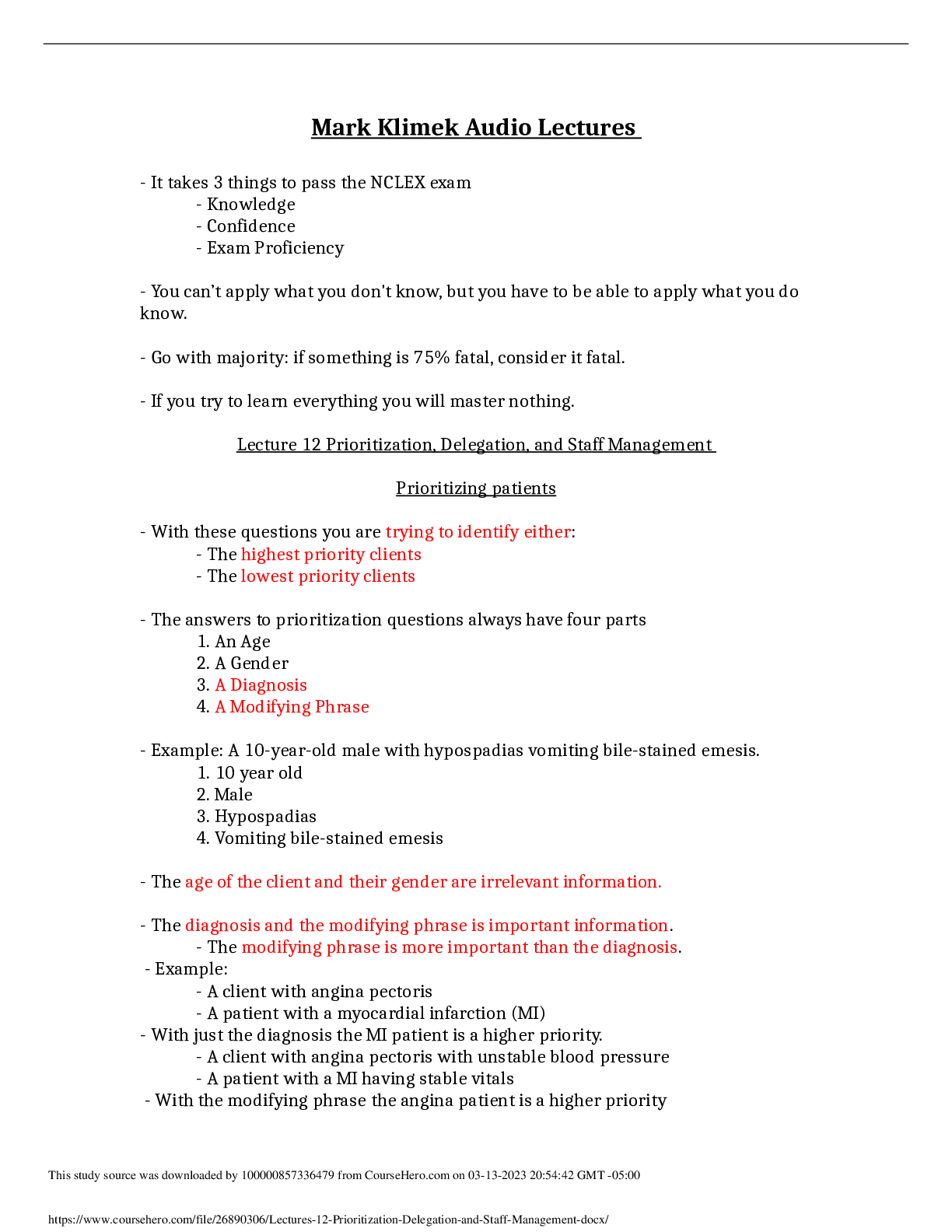



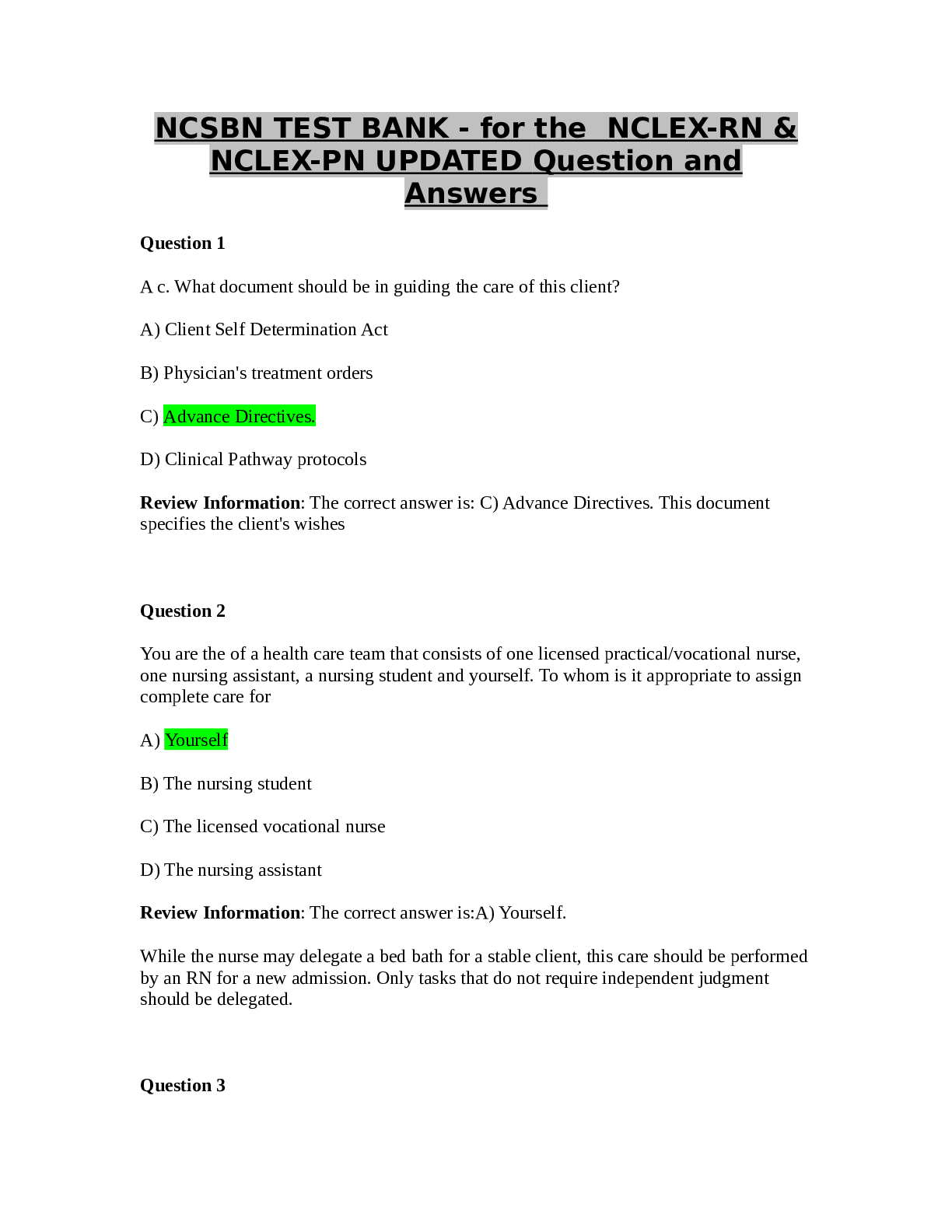
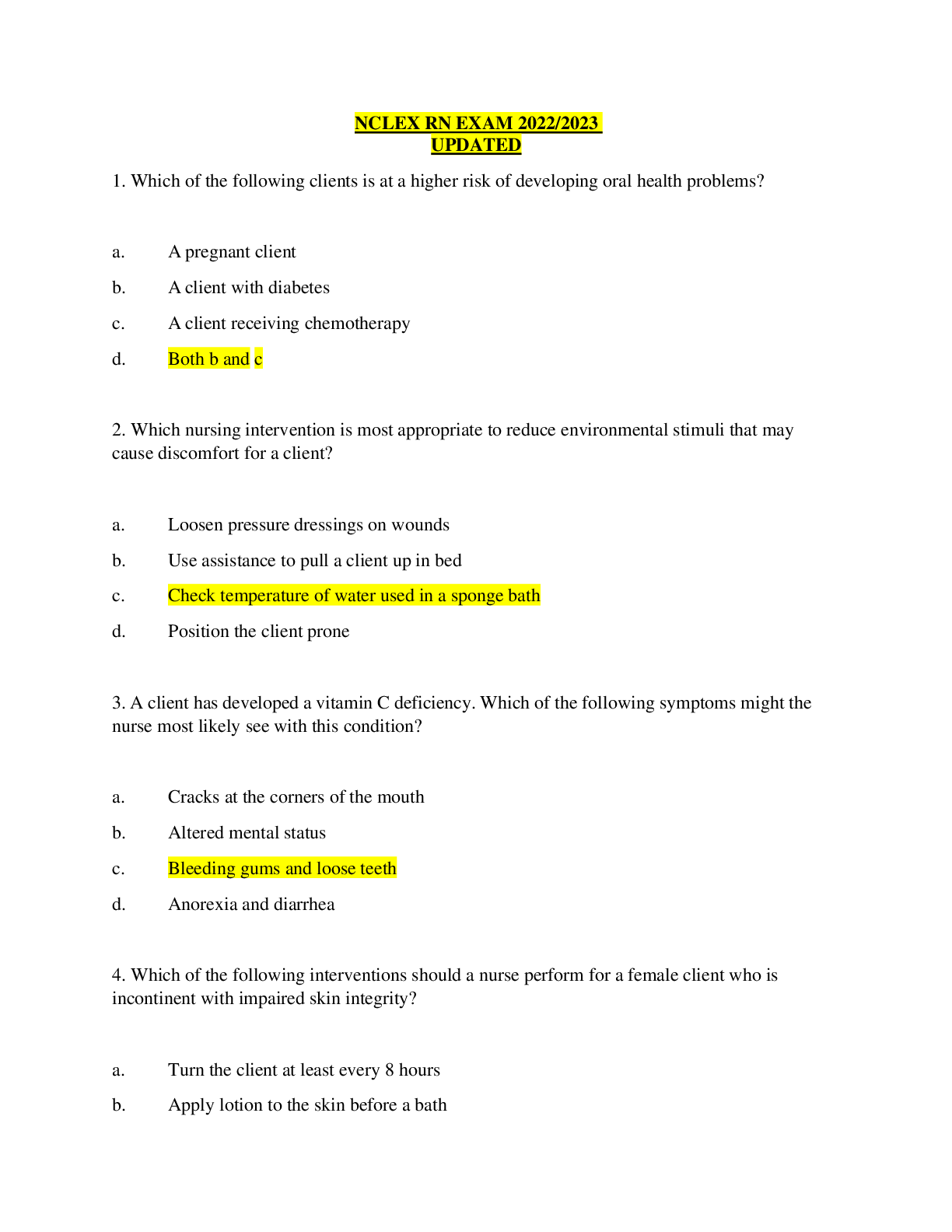
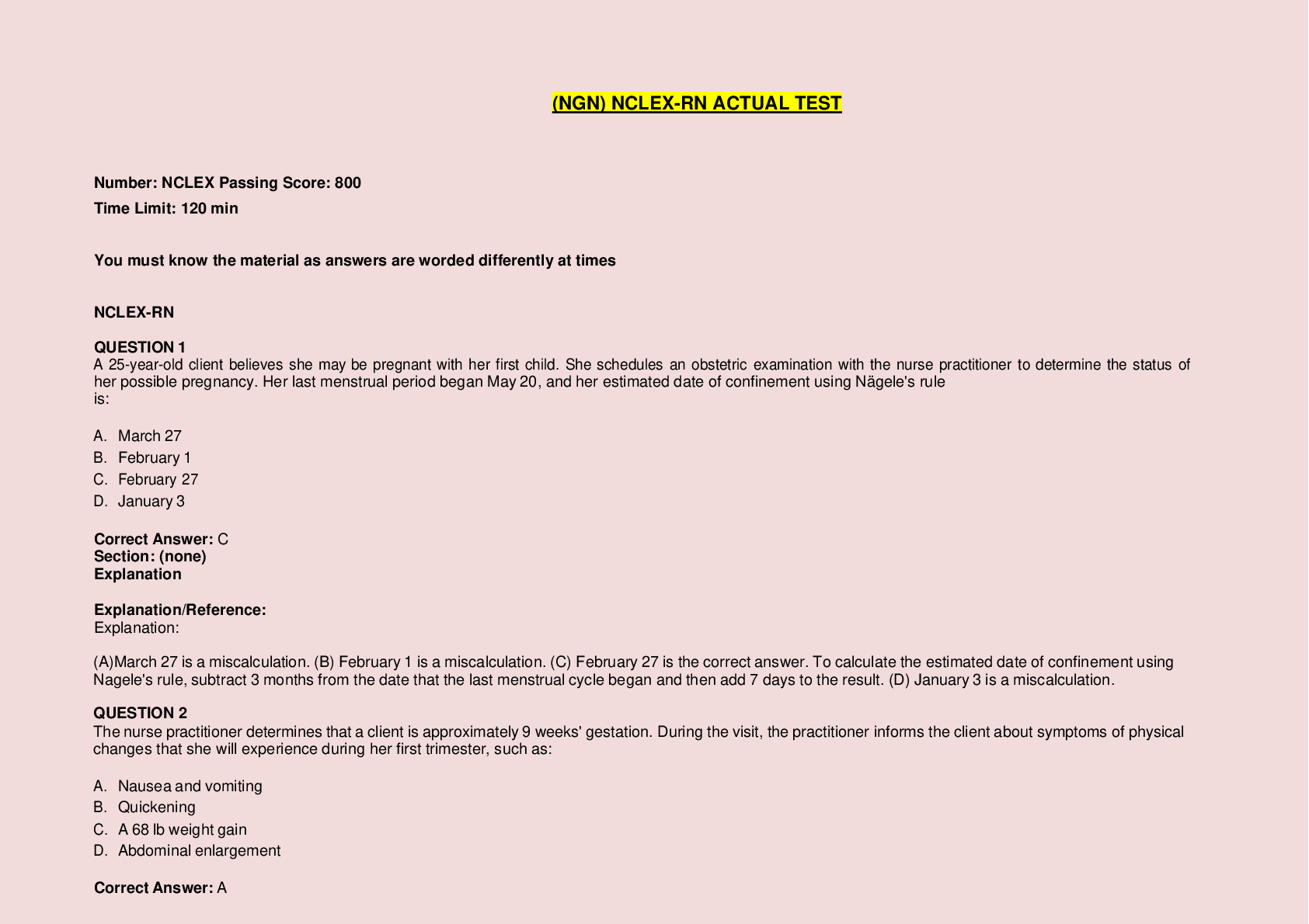
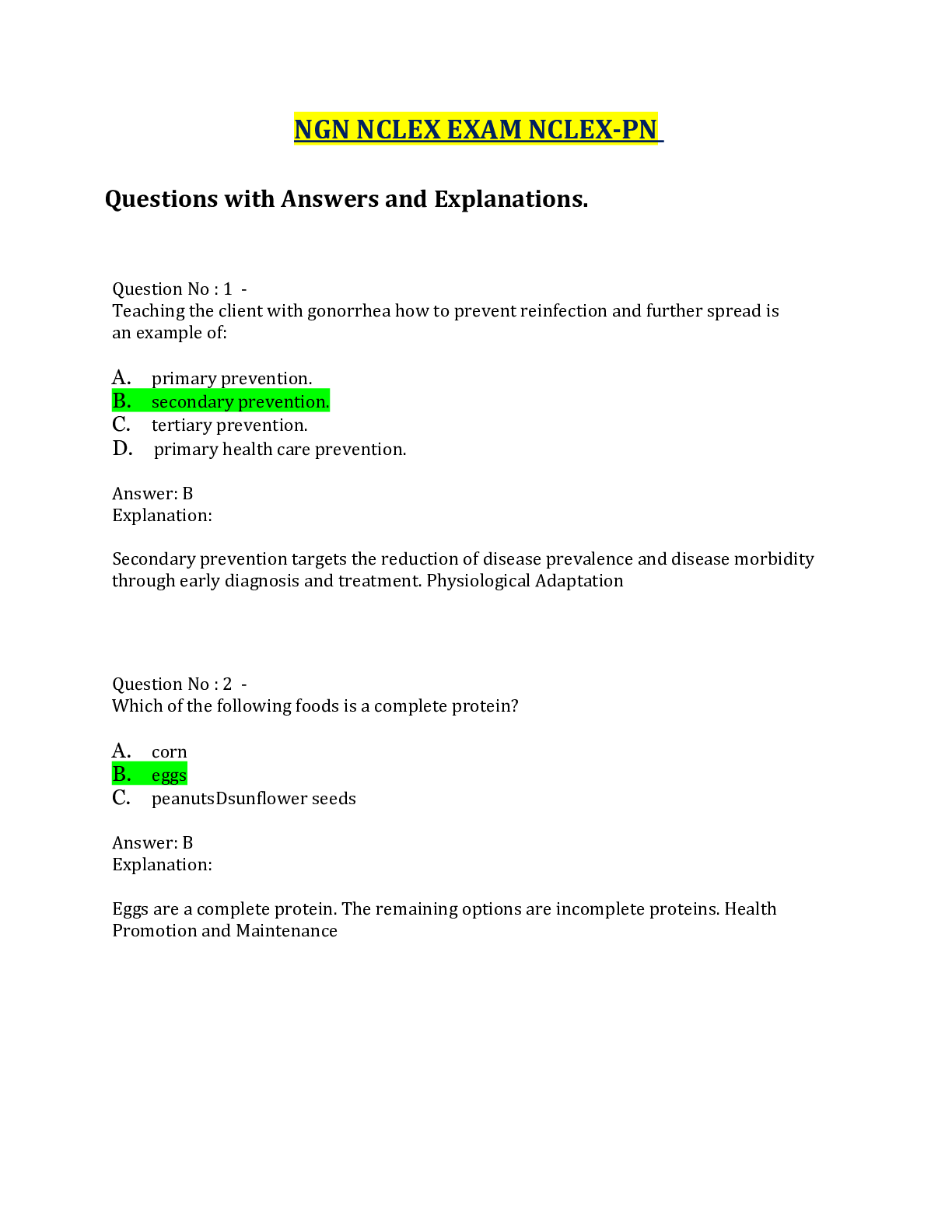

 JN21.png)

